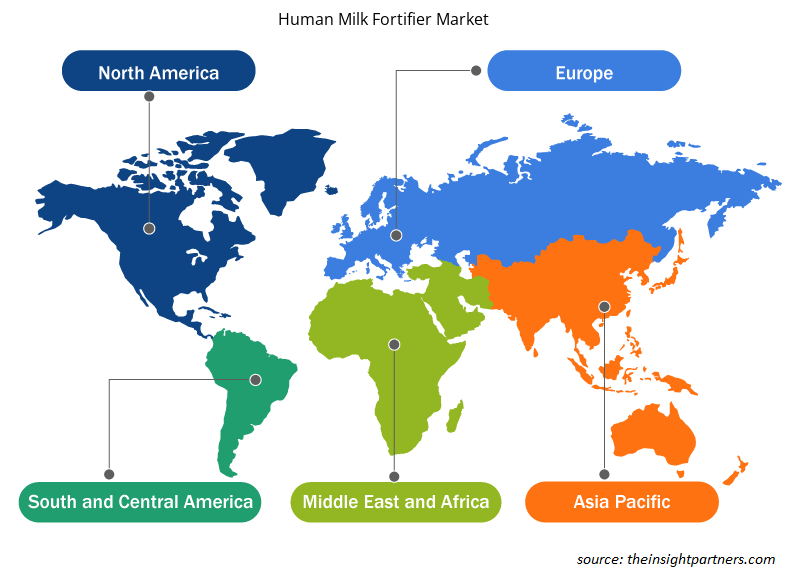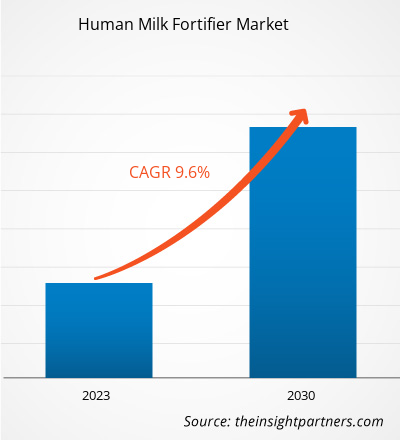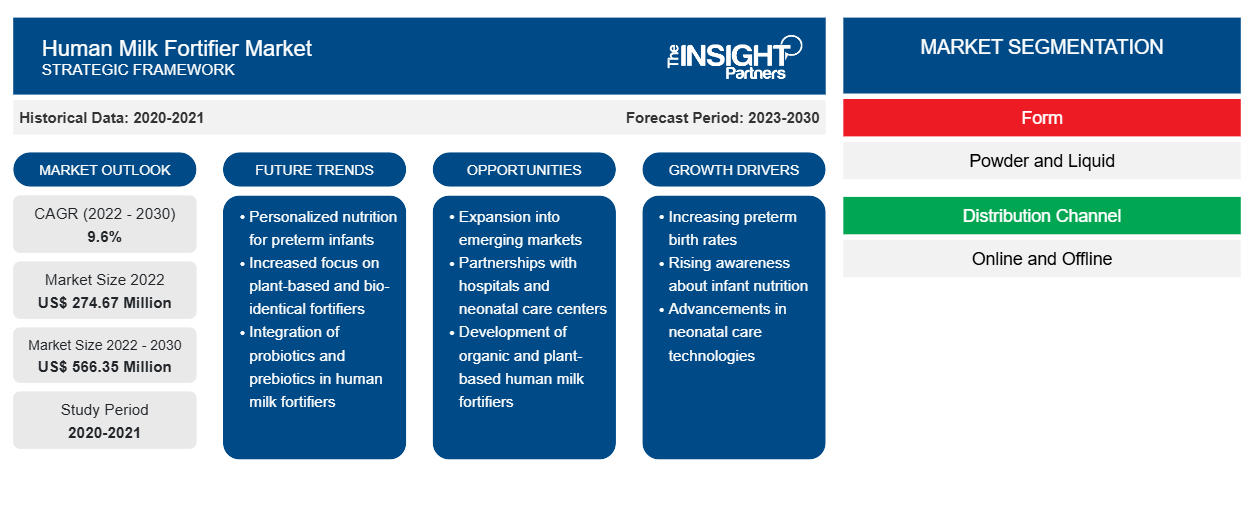[Rapporto di ricerca] Si prevede che il mercato degli integratori per il latte umano crescerà da 274,67 milioni di dollari nel 2022 a 566,35 milioni di dollari entro il 2030; si stima che registrerà un CAGR del 9,6% dal 2023 al 2030.
Approfondimenti di mercato e opinioni degli analisti:
I fortificatori del latte umano sono integratori nutrizionali aggiunti al latte umano per fornire calorie, elettroliti e vitamine aggiuntive ai neonati. Sono comunemente prescritti ai neonati prematuri nell'unità di terapia intensiva neonatale (NICU) per garantire l'assunzione di nutrienti e migliorare lo sviluppo e la crescita complessivi. Inoltre, anche ai neonati con basso peso vengono prescritti fortificatori del latte umano.
Fattori di crescita e sfide:
Negli ultimi anni, il numero di nascite premature è aumentato a causa dei cambiamenti negli stili di vita e di malattie croniche come diabete e ipertensione. Secondo i Centers for Disease Control and Prevention (CDC), nel 2021, la nascita pretermine ha colpito circa 1 neonato su dieci negli Stati Uniti. Il tasso di nascite premature negli Stati Uniti è salito dal 10,1% nel 2020 al 10,5% nel 2021. L'Organizzazione mondiale della sanità (OMS) ha stimato che nel 2020 siano nati circa 13,4 milioni di bambini. La complicazione della nascita pretermine è la principale causa di morte tra i bambini di età inferiore ai cinque anni, responsabile di circa 900.000 decessi nel 2019. I neonati prematuri possono avere problemi respiratori, difficoltà di alimentazione, ritardi nello sviluppo, paralisi cerebrale e problemi di vista e udito.
Il crescente numero di nascite premature ha fatto aumentare la domanda di fortificanti del latte umano per la corretta crescita e sviluppo dei neonati. Molti neonati prematuri hanno bisogno di nutrienti extra aggiunti al latte materno. Spesso hanno bisogno di proteine, calcio, fosforo e sale extra per costruire ossa forti e organi sani. I fortificanti del latte umano aiutano a fornire questi nutrienti extra ai neonati. Nei fortificanti del latte umano, vengono aggiunti nutrienti aggiuntivi al latte prima che venga somministrato ai neonati. Quindi, un aumento delle nascite premature rafforza la crescita del mercato dei fortificanti del latte umano .
I governi hanno imposto varie regole e normative relative alla produzione e all'uso di fortificanti del latte umano per garantire la sicurezza dei neonati e mantenere gli standard qualitativi del prodotto. In Canada, i fortificanti del latte umano sono regolamentati dalle Norme sugli alimenti e i farmaci (FDR). La norma FDR, Parte B, Divisione 25 (B.25.019) è implementata per garantire le vendite appropriate di fortificanti del latte umano sotto un'adeguata supervisione medica. Inoltre, il fortificante del latte umano deve fornire a Health Canada una presentazione pre-commercializzazione. La Sezione B.25.011, sottosezioni (a) a (n), specifica i requisiti normativi per un nuovo fortificante del latte umano. Negli Stati Uniti, il fortificante del latte umano è classificato come formula per neonati esente; tuttavia, i produttori devono soddisfare i requisiti della Food and Drug Administration (FDA) statunitense, che garantisce la dichiarazione dei nutrienti, inclusa la quantità di ciascun minerale e vitamina elencata negli allegati del prodotto. L'implementazione di tali normative ha ostacolato la produzione di fortificanti del latte umano, frenando la crescita del mercato.
Personalizza questo report in base alle tue esigenze
Riceverai la personalizzazione gratuita di qualsiasi report, comprese parti di questo report, o analisi a livello nazionale, pacchetto dati Excel, oltre a usufruire di grandi offerte e sconti per start-up e università
-
Scopri le principali tendenze di mercato in questo rapporto.Questo campione GRATUITO includerà analisi di dati che spaziano dalle tendenze di mercato alle stime e alle previsioni.
Segmentazione e ambito del report:
Il mercato globale dei fortificatori del latte umano è segmentato in forma, canale di distribuzione e area geografica. Il mercato dei fortificatori del latte umano è segmentato in polvere e liquido in base alla forma. Il mercato dei fortificatori del latte umano è categorizzato online e offline in base ai canali di distribuzione. Il mercato globale dei fortificatori del latte umano è ampiamente segmentato in base all'area geografica in Nord America, Europa, Asia Pacifico, Medio Oriente e Africa e Sud e Centro America.
Analisi segmentale:
In base alla forma, il mercato dei fortificatori del latte umano è segmentato in polvere e liquido. Si prevede che il segmento in polvere registrerà un CAGR più elevato durante il periodo di previsione. I fortificatori del latte umano in polvere integrano e migliorano il contenuto nutrizionale del latte materno. Il latte materno fortificato è prescritto ai neonati prematuri o fragili dal punto di vista medico. Le persone preferiscono i fortificatori del latte umano in polvere per la loro praticità di conservazione, manipolazione e preparazione. Inoltre, sono più facili da conservare e trasportare, garantendo al contempo una durata di conservazione più lunga rispetto ai prodotti liquidi.
In base al canale di distribuzione, il mercato dei fortificatori del latte umano è suddiviso in online e offline. Si prevede che il segmento online registrerà un CAGR più elevato durante il periodo di previsione. I negozi al dettaglio online sono associati alla comodità di fare acquisti comodamente da casa. I genitori possono cercare e acquistare fortificatori del latte umano in qualsiasi momento adatto a loro senza visitare un negozio. Inoltre, le piattaforme online spesso forniscono loro l'accesso a un'ampia gamma di fortificatori, consentendo ai genitori di esplorare varie opzioni e scegliere il prodotto più adatto. Inoltre, i fortificatori del latte umano potrebbero non essere disponibili nei negozi locali o specializzati; i negozi online forniscono l'accesso a un inventario più ampio, rendendo più facile per i consumatori trovare marchi specifici non disponibili nella loro località. Le recensioni dei clienti e le informazioni dettagliate sul prodotto aiutano ulteriormente i genitori a prendere decisioni più consapevoli. Leggendo le recensioni di altri genitori che hanno utilizzato il prodotto, possono ottenere informazioni sulla sua efficacia e idoneità. I rivenditori online offrono spesso prezzi competitivi grazie a costi generali inferiori rispetto ai negozi fisici. Ciò può avvantaggiare gli utenti che cercano opzioni economiche o confrontano i prezzi tra diversi venditori. Inoltre, alcuni utenti potrebbero preferire acquistare fortificatori del latte umano in modo discreto perché sono sensibili a discutere pubblicamente della salute del loro bambino. I canali online offrono privacy e consentono acquisti e consegne discreti.
Analisi regionale:
In base alla geografia, il mercato della farina di riso è suddiviso in cinque regioni chiave: Nord America, Europa, Asia Pacifico, Sud e Centro America e Medio Oriente e Africa. Il mercato in Nord America è stato valutato a circa 85,82 milioni di $ USA nel 2022. Si stima che l'Asia Pacifico registrerà un CAGR di circa il 10,4% durante il periodo di previsione. Con l'aumento dei livelli di reddito disponibile nell'Asia Pacifico, più genitori possono permettersi prodotti sanitari di alta qualità, tra cui i fortificatori del latte umano. Ciò ha contribuito alla crescita del mercato, poiché i genitori sono disposti a investire in prodotti che possono migliorare la salute e il benessere dei propri figli. Inoltre, l'espansione delle infrastrutture sanitarie, tra cui le unità di terapia intensiva neonatale (UTIN), nell'area Asia Pacifico ha creato un ambiente favorevole per la crescita del mercato dei fortificatori del latte umano. Ospedali e strutture sanitarie sono meglio attrezzati per fornire cure specialistiche ai neonati prematuri, aumentando la domanda di fortificatori del latte umano.
Approfondimenti regionali sul mercato dei fortificatori del latte umano
Le tendenze regionali e i fattori che influenzano il mercato degli integratori per il latte umano durante il periodo di previsione sono stati ampiamente spiegati dagli analisti di Insight Partners. Questa sezione discute anche i segmenti e la geografia del mercato degli integratori per il latte umano in Nord America, Europa, Asia Pacifico, Medio Oriente e Africa e Sud e Centro America.

- Ottieni i dati specifici regionali per il mercato dei fortificatori del latte umano
Ambito del rapporto sul mercato degli fortificanti del latte umano
| Attributo del report | Dettagli |
|---|---|
| Dimensioni del mercato nel 2022 | 274,67 milioni di dollari USA |
| Dimensioni del mercato entro il 2030 | 566,35 milioni di dollari USA |
| CAGR globale (2022-2030) | 9,6% |
| Dati storici | 2020-2021 |
| Periodo di previsione | 2023-2030 |
| Segmenti coperti |
Per modulo
|
| Regioni e Paesi coperti |
America del Nord
|
| Leader di mercato e profili aziendali chiave |
|
Densità dei player del mercato dei fortificatori del latte umano: comprendere il suo impatto sulle dinamiche aziendali
Il mercato degli integratori per il latte umano sta crescendo rapidamente, spinto dalla crescente domanda degli utenti finali dovuta a fattori quali l'evoluzione delle preferenze dei consumatori, i progressi tecnologici e una maggiore consapevolezza dei benefici del prodotto. Con l'aumento della domanda, le aziende stanno ampliando la propria offerta, innovando per soddisfare le esigenze dei consumatori e capitalizzando sulle tendenze emergenti, il che alimenta ulteriormente la crescita del mercato.
La densità degli operatori di mercato si riferisce alla distribuzione di aziende o società che operano in un particolare mercato o settore. Indica quanti concorrenti (operatori di mercato) sono presenti in un dato spazio di mercato in relazione alle sue dimensioni o al valore di mercato totale.
Le principali aziende che operano nel mercato degli integratori per il latte umano sono:
- Laboratori Abbott
- NeoLacta Lifesciences Pvt Ltd
- Nestlé SA
- Prolacta Bioscience Inc
- Lead Care International Ltd
Disclaimer : le aziende elencate sopra non sono classificate secondo un ordine particolare.

- Ottieni una panoramica dei principali attori del mercato dei fortificatori del latte umano
Sviluppi del settore e opportunità future:
Di seguito sono elencate le varie iniziative intraprese dai principali attori operanti nel mercato degli integratori per il latte umano:
- A gennaio 2022, Prolacta Bioscience ha introdotto fortificanti del latte umano in Giappone. Il lancio mirava a entrare nel mercato inesplorato del paese e ad aiutare a migliorare la salute dei neonati. A novembre 2020, Lifeblood Milk e il South Australian Health and Medical Research Institute (SAHMRI) hanno avviato una collaborazione con CSIRO, l'agenzia scientifica nazionale australiana. La partnership mirava a sviluppare fortificanti del latte umano per migliorare la nutrizione e la crescita nei neonati prematuri.
- A settembre 2021, Neolacta Lifesciences Pvt. Ltd ha lanciato i suoi prodotti su piattaforme di e-commerce per garantire ai genitori una facile reperibilità dei suoi prodotti, come Neolacta Human Breast Milk e Neolacta MMF (Mother's Milk Fortifier).
Impatto del Covid-19:
La pandemia di COVID-19 ha inizialmente colpito il mercato globale degli integratori per il latte umano a causa della chiusura delle unità produttive, della carenza di manodopera, dell'interruzione delle catene di fornitura e dell'instabilità finanziaria. L'interruzione di vari settori dovuta al rallentamento economico causato dall'epidemia di COVID-19 ha frenato la domanda di integratori per il latte umano. Tuttavia, le aziende stanno guadagnando terreno poiché le limitazioni precedentemente imposte sono state allentate in vari paesi. Inoltre, l'introduzione dei vaccini COVID-19 da parte dei governi di diversi paesi ha alleviato la situazione, portando a un aumento delle attività commerciali in tutto il mondo. Diversi mercati, tra cui il mercato degli integratori per il latte umano, hanno assistito a una crescita dopo l'allentamento dei lockdown e delle restrizioni alla circolazione.
Scenario competitivo e aziende chiave:
Tra i principali attori del mercato mondiale degli integratori per il latte umano figurano Abbott Laboratories, NeoLacta Lifesciences Pvt Ltd, Nestle SA, Prolacta Bioscience Inc, Lead Care International Ltd, Raptakos, Brett & Co Ltd, NeoKare Nutrition Ltd, Danone SA, Neolac Inc e Reckitt Benckiser Group Plc.
- Analisi storica (2 anni), anno base, previsione (7 anni) con CAGR
- Analisi PEST e SWOT
- Valore/volume delle dimensioni del mercato - Globale, Regionale, Nazionale
- Industria e panorama competitivo
- Set di dati Excel
Report recenti
Rapporti correlati
Testimonianze
Motivo dell'acquisto
- Processo decisionale informato
- Comprensione delle dinamiche di mercato
- Analisi competitiva
- Analisi dei clienti
- Previsioni di mercato
- Mitigazione del rischio
- Pianificazione strategica
- Giustificazione degli investimenti
- Identificazione dei mercati emergenti
- Miglioramento delle strategie di marketing
- Aumento dell'efficienza operativa
- Allineamento alle tendenze normative























 Ottieni un campione gratuito per - Mercato degli integratori per il latte umano
Ottieni un campione gratuito per - Mercato degli integratori per il latte umano